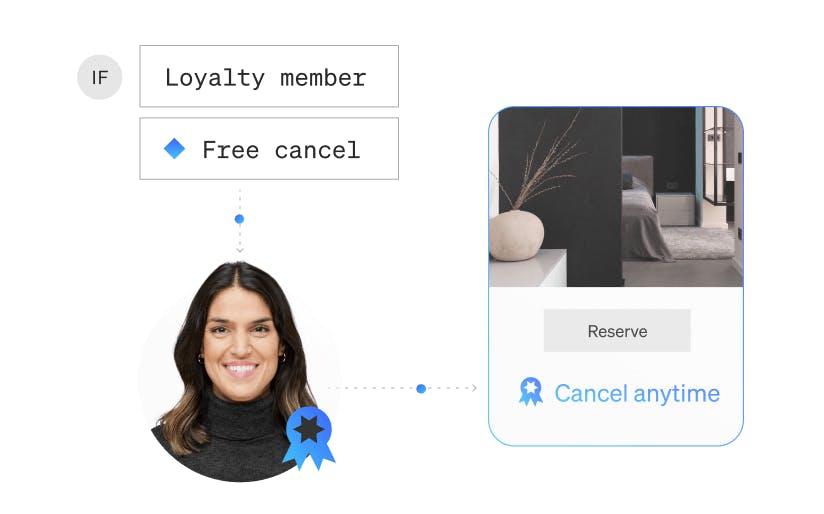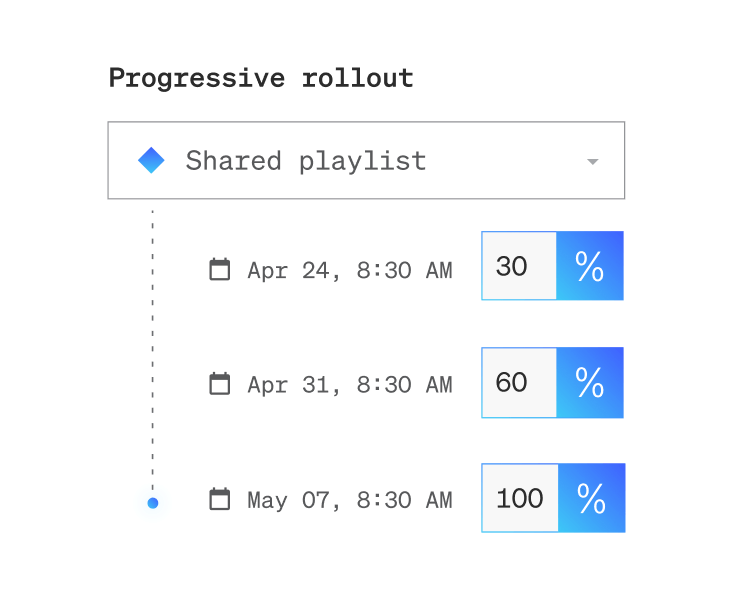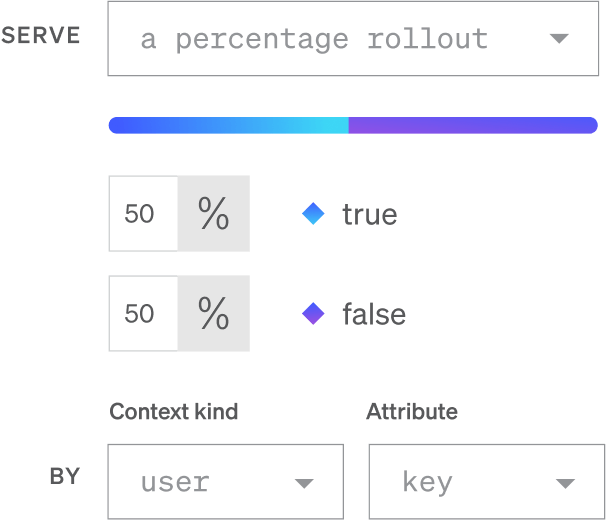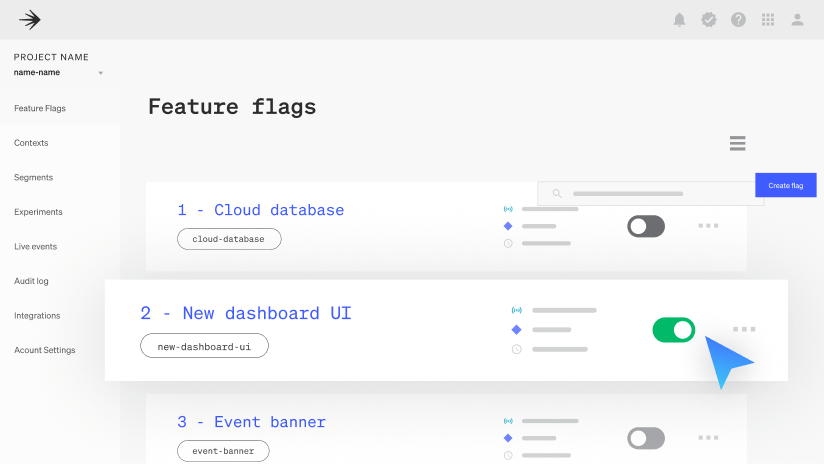Elevate product experiences with precise targeting
How to serve software features tailored to any audience without burdening engineers.

How LaunchDarkly can help
Robust targeting engine vs. lightweight targeting tools
Many personalization tools offer superficial, front-end customization in terms of appearance, layout, and content. But they don’t address the comprehensive depth required for personalization done at the core of a service or set of services.
LaunchDarkly, on the other hand, provides a secure targeting engine that covers the full-stack (server-side and client-side) on a large scale. It delivers personalized, functional product experiences, in which entire applications and all their services are seamlessly coordinated.
In the following sections, we'll explore how LaunchDarkly's targeting engine and feature flags address the three main barriers to delivering targeted experiences.
Feature flags
Feature flags are conditional statements (e.g., if-else) that allow developers to deploy features to a production environment without making them visible to end-users. That is, they decouple deploy from release. With feature flags and targeting in LaunchDarkly, you can release software changes to specific users, segments, devices, applications, platforms, and so on in a live production environment. This reduces risk when releasing. And it gives you the control to deliver personalized software experiences.
1. Target based on anything you know about your audience
LaunchDarkly allows you to target based on anything you know about your audience. And when we say “anything”, we really mean anything. This, in turn, enables you to govern critical parts of user experiences, tailoring them to each audience segment and adapting them to changing conditions—without requiring custom code.
Target on your terms
LaunchDarkly allows businesses to personalize user experiences based on any attribute or combination of attributes with context-aware targeting. Custom contexts in LaunchDarkly enable you to define and target against any and all details about users, applications, or other facets of your business.
You can build targeting rules, segments, and experiments using your application’s data model, ensuring seamless integration with your existing infrastructure. Moreover, LaunchDarkly supports infinite contexts and attributes—i.e., targeting objects—across different applications and services, allowing you to customize without limits. By using a single flag to target multiple context kinds (e.g., device type, geolocation, user demographic data, operating system, etc.), LaunchDarkly streamlines the targeting process and minimizes technical debt.
When targeting perfectly reflects your business language and data model, teams make smarter decisions about how they release and customize features. Customers get personalized experiences, leading to higher engagement, retention, and revenue.
Automate feature entitlements
Businesses leveraging LaunchDarkly can grant the right users access to the right features based on customer tier (e.g., Premium v. Basic v. Free), local regulations, account-specific parameters, and more. One way to accomplish this is by creating dynamic targeting groups using LaunchDarkly’s segments, which are reusable across flags to ensure consistent entitlement management at scale.
Here’s how one LaunchDarkly customer, a software corporation with over 200K customers, uses our targeting capabilities for plan management. If a new customer signs up for their premium subscription, a flag will automatically give that customer access to all the appropriate enterprise features while barring non-enterprise customers. In another more advanced case, the company has VIP-status customers that receive custom features that are not available to the rest of their customer base. Supporting these custom feature access scenarios is arduous and time-consuming from an engineering perspective. But with LaunchDarkly, they’re able to implement these exceptions quickly and effortlessly without shipping any code changes.

Securely leverage predefined user groups
With LaunchDarkly, businesses are able to target segments through integrations with customer data platforms (CDPs) like Segment and Amplitude.
These integrations provide businesses an easy way to combine LaunchDarkly’s data with real-time data from their CDP. In doing so, you gain a unified and comprehensive view of user behavior and preferences, empowering businesses to create highly targeted user segments, personalize experiences, and enhance feature releases. This also means you don’t need to recreate user segments from scratch over and over again. You can target pre-existing segments quickly and easily.
Using Segment with LaunchDarkly to deliver enterprise offerings
In following these simple steps, you can enable the right enterprise features for your enterprise customers in a streamlined way. Rather than re-creating a separate copy of the enterprise audience segment in LaunchDarkly, you can sync the canonical audience data from Segment.
- Integrate your Segment account with LaunchDarkly.
- Identify the audience in Segment that includes enterprise customers and sync it to LaunchDarkly for precise targeting.
- Create feature flags in LaunchDarkly to control the enterprise features you want to enable.
- Configure the feature flags to target the synced enterprise user segment.
2. Test features with a subset of users
LaunchDarkly enables businesses to vet features with small audiences in production before releasing to an entire userbase. Easily control who gets which features when for faster feedback and a shorter time-to-value.
Progressively deliver
LaunchDarkly allows businesses to safely roll experiences out to specific segments and environments in production. You can start small and catch problems early with real data.
LaunchDarkly provides a safe, controlled, and incremental approach to feature releases. Such an approach gives developers the safeguards and control to move faster. With feature flags, developers can enable or disable specific features for targeted user segments in real-time—that is, without having to push code through your deployment pipeline. You can progressively expose new features to a subset of users while closely monitoring the impact on production systems and the user experience.
Progressive delivery lets you limit the blast radius of issues that may occur in your application. Limiting the blast radius is one way that developers can “safely” test code in a live production environment. Again, the advantage of testing in production is that, compared to artificial pre-production testing, it gives you a much better idea of how a software change will impact operational health.
Through enabling progressive delivery, LaunchDarkly ensures your release process aligns with what’s best for customers and the business.
Progressive rollout
First, roll a feature out to a small group of internal testers (canary group) in production. Once the feature passes this gate, expand the rollout to a small group of beta testers. After this gate, expand to iOS devices in North America, then to Android devices in North America, and so on until you’ve released to all the intended users and devices. You can do all this with feature flags and targeting in LaunchDarkly.

Easily run beta tests
With LaunchDarkly, you can quickly search and add users to beta and early access groups, allowing you to iterate based on early feedback to deliver better software.
LaunchDarkly makes it easy to test different variations of a feature or compare multiple versions with beta groups in a realistic production setting. Beta testing enables continuous improvements as product managers can receive early feedback, identify issues, and refine features before a full release. This leads to a better product experience and higher customer engagement in the end.
For example, product managers at Seesaw, a learning platform used by over 10 million teachers, students, and family members in more than 130 countries, used LaunchDarkly to beta test a new lesson library product offering with specific customers. They iterated on feedback they received from beta users and optimized the new features accordingly. Emily Voigtlander, a Product Manager at Seesaw, said the lesson library was the “most rapidly and widely adopted feature” since the release of the original Seesaw platform. Typically, it would take nearly a year for a teacher (customer) to adopt a new Seesaw feature. But the lesson library was adopted “much, much faster than that”.
Unlock percentage rollouts
LaunchDarkly allows you to gradually roll features out to small cohorts representing a random sampling of customers. With these percentage rollouts, you control the percentage of users who have access to a feature at a given time.
Businesses will often use targeting and percentage rollouts in tandem. By combining the two practices, businesses strategically introduce new products or features to the right audience while mitigating risks and maximizing the chances of success. It enables iterative improvements, personalized marketing, and data-driven decisions for better overall outcomes.
For example, a business may want to roll out a feature to Safari web browsers first before releasing to other devices. They’ll want to gradually release to the Safari segment, and will start by rolling out to a random 10% of users in the Safari segment, then expand to 25%, and so on. This gives businesses the opportunity to address any issues that may arise before expanding access to the feature to a wider group of users.

3. Let business teams control targeting
Targeting functionality to specific audiences typically requires developers to write and deploy code. LaunchDarkly changes that. With LaunchDarkly, non-developers can manage targeting workflows, resulting in greater customer satisfaction, engagement, and conversions.
Point and click
LaunchDarkly provides an intuitive UI along with guardrails to help business stakeholders define audiences, add users to prebuilt segments, and manage releases.
When engineers build a homegrown targeting solution, they typically don't include an intuitive UI, as it requires even more development work. Without a user-friendly interface, non-developers can’t interact with the system and are thereby excluded from the targeting process.
LaunchDarkly, on the other hand, provides a user-friendly interface to enable developers and non-developers to manage targeting. By involving business stakeholders in the targeting process, you free up valuable engineering time for higher-value development projects. This increases efficiency and creates a more collaborative targeting process that scales across the business. Giving business stakeholders more control over targeting also allows them to incorporate their knowledge of customers into the release process, resulting in a better product experience for those customers.

Control access across your organization
LaunchDarkly allows you to only give specific people access to production. And it can automatically require and enforce change approvals.
LaunchDarkly's custom role-based access controls (RBAC) give engineering teams the confidence to allow certain business stakeholders to have more control over targeting. Engineers and the business don't want just anyone to target and touch production systems—only specific, trusted, vetted people. By leveraging RBAC in LaunchDarkly, everyone can rest assured that the right people have the necessary privileges to safely manage and influence production environments.
Engineers can define custom roles and permissions tailored to their team’s specific needs, ensuring that each team member has the appropriate level of access to manage and configure feature flags, user segments, and other aspects of feature flag management. With custom RBAC, businesses gain enhanced security, collaboration, and alignment with their internal workflows and processes.
Integrate with dev workflows
LaunchDarkly enables development and business teams to share a single process in a unified platform. LaunchDarkly bridges the gap between engineers and non-engineers in the following way. First, it integrates with engineers’ existing tech stack. With 25+ SDKs and over 55 integrations across popular developer, operations, and data analytics tools, LaunchDarkly fits seamlessly into your existing technology infrastructure and workflows. Second, it is user-friendly-enough for product managers, release managers, and other non-engineers to confidently use the platform.
LaunchDarkly streamlines workflows and facilitates collaboration across the entire product delivery team, all of which results in a better customer experience. Building a comparable in-house targeting solution is challenging and time-consuming. It requires significant development effort, maintenance, and ongoing support. Maintaining a homegrown solution requires bug fixes, updates, and compatibility with other tools in the software delivery lifecycle. Addressing scalability, performance, and security aspects of a homegrown solution adds even more complexity, requiring careful coordination and specialization. But with LaunchDarkly, you get all the benefits without the homegrown headaches.

4 targeting use cases to elevate your business
LaunchDarkly’s targeting engine unlocks several use cases that drive business growth. Below, we’ve summarized some of the main use cases that we’ve covered throughout this guide.
1. Progressive delivery
Introduce new functionality to a select group of users or environments instead of deploying it to all users simultaneously. By starting small and collecting real data, businesses can detect and address issues early on, minimizing risks as they expand the rollout.
2. Early access and beta testing
Empower business stakeholders, such as product managers, to effortlessly create beta segments and test new features with these segments. By incorporating valuable customer feedback at an early stage, businesses can enhance product quality and elevate the overall customer experience.
3. Entitlements
Grant users access to specific features based on variables like subscription tier (Premium vs. Basic), location-specific regulations, or other account-specific variables. This enhances operational efficiency and delivers a seamless customer experience.
4. Personalization
Take customer experiences to new heights by tailoring product experiences to individual user behavior, demographic data, or other custom attributes. By providing personalized experiences, businesses can dramatically improve customer satisfaction.
Now that we understand how LaunchDarkly enables businesses to control and scale targeted experiences, let's see how this looks in the real world.













